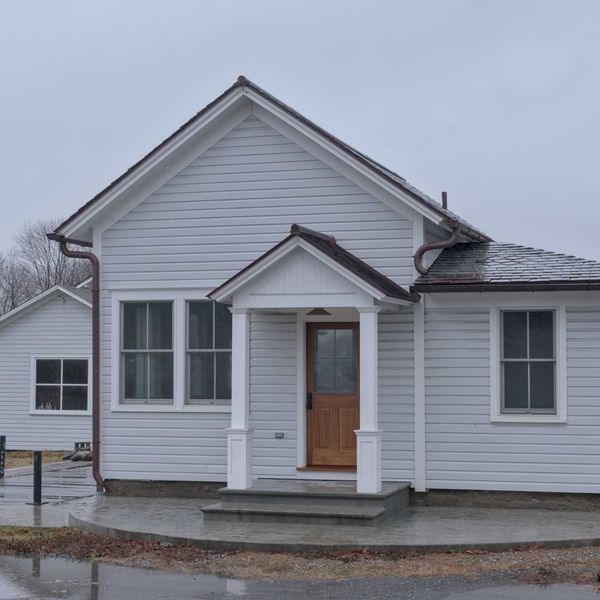Louis Dingee spends a lot of time on the road. He regularly drives two hours round-trip from his home in Torrington to Kent, where he volunteers with the Kent Volunteer Fire Department (KVFD).
Louis has been with KVFD since age 14, when he participated in the junior members program after school. By the time he was 19, Louis was a full member, and he’s been with the Department for more than two decades since.
“Getting early exposure to the Department is what drove me to continue,” he says. “They’ve grown to be a family to me. I do it for the Kent community – I love giving back to where I used to live.”
Louis used to live in Kent. In recent years, the local housing market has completely priced him out. Due to his two hour commute, sometimes Louis is unable to respond to emergency dispatches. “In many cases, by the time I’d arrive, I’d basically be meeting them at the hospital,” he explains.
Louis’s dream home is modest. He just needs a garage where he can keep his electrician equipment, and a zip code close enough to Kent so that he can respond to emergency calls. But for now, Torrington is the only financially feasible option.
In fact, Louis’s situation is not unique. KVFD has lost multiple members over the past few years due to the high cost of housing in Kent. One former volunteer found housing in Sharon, and now volunteers at the Sharon Fire Department. A few members moved to New Milford, where they struggle to balance the commute to Kent with work and family commitments.
In some cases, the relationship between affordable housing and volunteerism is less obvious than forced moves, but still impactful. Alan Gawel, Kent’s Fire Chief, has seen more people working two jobs in order to afford housing in Kent. In Gawel’s words, “if you’re working two jobs, where do you find the time to commit to the Fire Department?”
John Russell, the President of KVFD, explains that KVFD’s recruitment and retention issues are especially worrisome because of the Department’s broad remit. KVFD covers not just fire protection services, but also first response, life support, and rescue services.
Four years ago, KVFD could rely entirely on volunteers for 24-hour Emergency Medical Services (EMS) coverage. But in recent years, dwindling volunteer numbers has created uncertainty.
“An ambulance call would come in and we would hope that a member could respond,” Russell recalls. “You can’t provide an emergency service on hope. So we had to outsource EMS coverage to the tune of $320,000 a year. ”
From this testimony, it’s easy to see why Kent’s firefighters support creating more affordable housing. More budget-friendly options would help the Department recruit new volunteers, namely younger residents who could afford to move to Kent.
It would also help retain existing volunteers, who wouldn’t need to move away or take on additional paid work to afford rent.
And of course, there’s a direct budgetary benefit as well. If the KVFD team could return to pre-pandemic volunteer numbers, they could reduce the amount of taxpayer dollars spent on staffing 24-hour EMS shifts.
For these reasons, KVFD is collaborating with Kent Affordable Housing, which secured a grant from the Litchfield County Center for Housing Opportunity to explore the feasibility of developing housing for volunteers.
The collaboration committee has met monthly since January, and an architect has begun conceptual plans for a few units in a small portion of the warehouse space behind the firehouse.
“Our goal is to make it possible for volunteers to live in Kent,” Chief Gawel says of the collaboration.
“I want people to have the ability to respond to emergency calls, go through training, and help with regular duties like fundraising without needing to work a second job or move away.”
Gawel is one year away from his 40th anniversary with the Department. Like Louis, he joined when he was a teenager. And like Louis, his love for the community has kept him volunteering for so long.
“People have a calling for this,” he told me. “I did, my uncle did, and my great-uncle did. I hope other young people will get the chance to live here, so that they can experience ‘the calling’ for themselves.
“Everyone should get the chance to give back to their community.”
Hannah Pouler is a resident of Salisbury.





 Max Amsterdam feeds a red panda at the Trevor-Lovejoy Zoo on the Millbrook School campus on Wednesday, Dec. 17. Amsterdam said he became interested in the school's zoo in his freshman year when he watched an older student perform a biopsy on a wolf that had passed away at the zoo.Photo by Aly Morrissey
Max Amsterdam feeds a red panda at the Trevor-Lovejoy Zoo on the Millbrook School campus on Wednesday, Dec. 17. Amsterdam said he became interested in the school's zoo in his freshman year when he watched an older student perform a biopsy on a wolf that had passed away at the zoo.Photo by Aly Morrissey






Longtime volunteer priced out of Kent housing market
This guest commentary from Hannah Pouler draws our attention to some of the real effects that rising housing costs has on our communities.